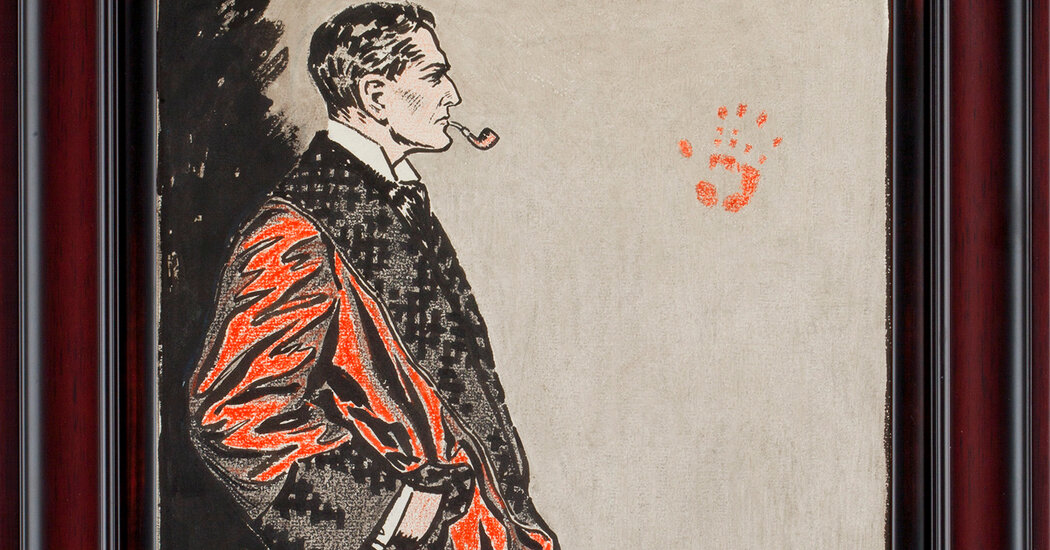
This has the makings of a detective story with hints of history: Why did Sir Arthur Conan Doyle sign a pirate edition of “The Sign of the Four,” the second of the four Sherlock Holmes novels? Conan Doyle hated pirate editions. He was as famous for denouncing pirate publishers as they were infamous for grinding out cheap editions — and not paying royalties to authors like him.
Consider the plot possibilities here. Did someone force Conan Doyle to write words above his name that he could not have meant — “Yours cordially”?
Sherlock Holmes and Watson are not available to tackle this one, but Glen S. Miranker is on the case. He acquired the evidence years ago.
Miranker is a former Apple executive who collects Holmesiana — items about Holmes, Watson and Conan Doyle. He owns more than 7,000 books, illustrations and letters. He has distilled them for “Sherlock Holmes in 221 Objects,” an exhibition that opens on Jan. 12 at the Grolier Club, 47 East 60th Street in Manhattan. The club says it is the first comprehensive Sherlock Holmes exhibition in New York City in more than 50 years.
It follows the strategy of “A History of the World in 100 Objects,” the BBC program of a decade ago, or “The Smithsonian’s History of America in 101 Objects,” published in 2013. The number 221 is a play on Holmes’s address, 221B Baker Street in London, the fictional home of the world’s most famous “consulting detective” — unfailingly rational, unprecedently popular and unimaginably able to avoid death at the pen of his creator. And whose fans have included everyone from T.S. Eliot to Isaac Asimov to Kareem Abdul-Jabbar.
“Sherlock Holmes in 221 Objects” is an excursion into the mind of a collector — the ones who collect anything and everything: pianos, stamps, books, furniture, one-of-a-kind objects. Displaying what they have assembled can explain why they did it — why they put so much time into tracking down little items they prize; why they spent so much money acquiring them if the items were, in fact, expensive; why locating them was so thrilling; and why, after all that, they still consider the items important.
Miranker “has the collection mania in its most acute form — and especially on this subject,” Leslie S. Klinger, the editor of “The New Annotated Sherlock Holmes,” wrote in a foreword to the exhibition catalog, applying a line from “The Illustrious Client.” But not once in a recent hourlong conversation did Miranker utter a Holmes cliché like “elementary” or “the little things are infinitely the most important.”
Miranker confessed to reveling in “the quest for things Sherlockian.”
“I’m not into collecting per se,” he said. “It’s the adventure, the emotional excitement of the chase that I relish — and the chance to form a special kind of relationship with a book, an author, a manuscript or an illustration. It really lets me in a visceral way into the life of Sherlock Holmes and Arthur Conan Doyle.”
Ah, yes, Holmes. Miranker called him “brilliant and so forth,” but also “an unlikable, misogynist misanthrope” with one friend in all the world.
“And yet he spends his life helping people,” Miranker said. “He’s driven by the pursuit of justice, his kind of justice. It speaks to something we’d like to see in ourselves, maybe not caring how we fit in but caring that we do the right thing.”
Miranker’s enthusiasm for Holmes and Conan Doyle, reflected in the exhibition, ranges from pages from “The Hound of the Baskervilles” to manuscripts of four short stories to handwritten letters from Conan Doyle.
There are some little things in the exhibition, like a Christmas card from the actor William Gillette, who adapted Holmes for the theater. “Did you ever imagine that Sherlock would be sending his compliments to his maker?” Gillette wrote on the card to Conan Doyle, sent in 1901.
There is an “idea book” in which Conan Doyle wrote “Killed Holmes” on the calendar for December 1893. There is also a handwritten speech, never before displayed, in which he explained why he did it: “I have been much blamed for doing that gentleman to death but I hold that it was not murder but justifiable homicide in self defence since if I had not killed he would certainly have killed me.”
Conan Doyle did it. He wrote a story for Holmes’s home, The Strand Magazine, in which he did Holmes in. Some 20,000 readers were so upset that they canceled their subscriptions. Conan Doyle brought him back a few years later.
By then, Holmes was so famous that he was pictured on books that were not about Holmes. One was “Escaped From Sing Sing,” with an image of a pipe-smoking man on the cover. Conan Doyle visited Sing Sing in 1914 and was briefly locked in a cell, “to see how it felt,” Miranker wrote in the catalog. Conan Doyle said it was “the most restful time I have had since I arrived in New York, for it was the only chance I had to get away from reporters.”
Miranker rediscovered Holmes as an undergraduate in the 1970s, when he was moping around his dorm and his roommate “grabbed this fat volume and threw it at me and said, ‘Here, read these — it will cheer you up.’” The book was a collection of Sherlock Holmes stories that he had read when he was young. Miranker savored them, so much so that he refused to read the last three or four for several years. He did not want to come to the end.
A couple of years later, by then married and in graduate school, he was glum and anxious about his doctoral thesis. His wife went out for several hours and returned with an American first edition of “The Casebook of Sherlock Holmes,” the collected short stories published in the 1920s. “I opened the book, and I had a revelation,” he said. “I said, ‘You don’t have to be J.P. Morgan to collect books?’ I said, ‘Where did you get this?’”
She said she had wandered into an antiquarian book fair. “I said, ‘Is it open tomorrow?’” It was, they went, he was hooked and she got a “curated by” credit on the title page of the exhibition catalog.
After graduate school Miranker worked at I.B.M., a couple of Silicon Valley start-ups and NeXT, a computer company started by Steve Jobs after he was ousted from Apple in the mid-1980s. Back at Apple in the 1990s, Jobs brought in Miranker, a move that made affording Holmesiana easier. “I don’t argue with the observation,” he said, adding that he had “assembled quite a respectable collection before I had any money.” This was less complicated then because, he said, “there were a lot more good things 25 years ago that were merely expensive, as opposed to ridiculous.”
Among them were pirated books, “probably the single largest assemblage in my collection.” He relishes the back story, for it is about how technological change reshaped society. The rotary press accelerated book publishing, and with inexpensive wood pulp paper, ultimately lowered the price of a hardcover volume. “This meant that people could buy a book for an hour’s wage instead of a week’s or a month’s wage,” he said. “The authors didn’t give their permission and didn’t get a nickel,” but the pirate publishers “did this country a great service. They made 25-cent books plentiful and gave people things they wanted to read.”
Back to the story of Conan Doyle’s signature — the one below the words “yours cordially.”
The clues are puzzling. The book he signed was a copy of “The Sign of the Four,” with its blue cover. The spine says it was published by Lovell, Coryell & Company. But the publisher listed on the title page was the United States Book Company. Two different publishers? The plot thickens. (Except that Miranker said it doesn’t. The United States Book Company was a conglomerate started by James W. Lovell that served as a parent company for subsidiaries like Lovell, Coryell & Company.)
Another clue: Inside the front cover is another signature, that of H.N. Higinbotham, president of the World’s Columbian Exposition in 1893 and president of the Field Columbian Museum from 1898 to 1908. He dotted the I’s in his name. He crossed the T with a horizontal line that ran all the way from the first H to the last m.
Higinbotham also wrote out the date — Oct. 12, 1894, the day he gave a dinner party for Conan Doyle, who was in Chicago on a lecture tour.
“Those are the facts,” Miranker said. “Now we get into assumption. He quickly ran out, bought the first Conan Doyle book he could find, shoved it under his nose and asked him to sign it.”
That sounds like case closed.
Not quite, Miranker said.
Conan Doyle “signed on the title page, which had the publisher on it, so unless he had his eyes closed,” he would have noticed it was a pirate edition. “But there’s no smoking gun, no letter that’s turned up that says ‘I even signed a pirated copy for my host because I was being gracious.’”







